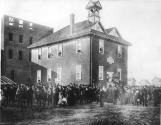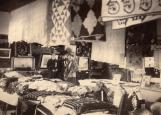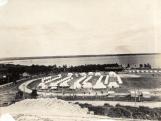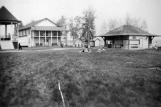2
There is probably no more enduring a tradition in New Liskeard than its annual fall fair. From its humbler beginnings in 1904 to the present, the fair has always provided an opportunity for the farming community and urban dwellers alike, to celebrate the harvest, learn about new technology, and exhibit livestock, produce, and crafts.The first agricultural society in New Liskeard was named the Temiskaming District Agriculture Society and founded in 1904.
At a June 1st meeting of that year, it was moved by Mr. Sharpe and seconded by Mr. McKewen that the society hold its fall fair on September 22nd and 23rd of that same year.
The society managed to obtain $600 in prize money- a substantial amount in 1904!
3
Scene of the first Fall Fair at the original New Liskeard Public SchoolFall 1904
New Liskeard, Ontario, Canada
 Credits:
Credits:Little Claybelt Homesteader's Museum
4
The site of that first fair was at the grounds of the old public school on Whitewood Avenue (where the Cenotaph Park now stands).5
Quilt exhibit at one of the earliest fairs held at the Public School1902-1905
New Liskeard, Ontario, Canada
 Credits:
Credits:Temiskaming Shores Public Library Archives
6
Judges were chosen for horses, cattle, sheep, swine, and poultry. Judges were also chosen for grain and produce as well as ladies work and fine arts.Three days after that first fair, the winners in the various categories were announced. While many of the original records of that event are illegible, a few are noted:
James Murray won first prize for his Empire State potatoes and a Mr. Baker took first for his Savoy cabbage.
Mr. Perrin won a first for some millet and fodder corn.
Prizes amounted to about $1 for each of those classes.
7
A vegetable display at the Temiskaming Fall FairCirca 1910
New Liskeard, Ontario, Canada
 Credits:
Credits:Agricultural Temiskaming, 1910
8
The first agricultural fair was considered by all, a success. It continued to be held at the same location over the next few years until 1908, when it was held at the new "Cement school" ( the new public school which had been constructed at the end of Mary Street). Without a permanent site, this would be the first of several moves for the fair.9
A Fall Wheat Exhibit at the Temiskaming Fall FairFall 1909
New Liskeard, Ontario, Canada
 Credits:
Credits:Agricultural Temiskaming, 1910
10
From the "Cement school" the fair moved across the Wabi River to the Ontariogovernment's demonstration farm and then in subsequent years relocated to the New Liskeard Beach. While the presence of a two-storey pavilion there allowed for good exhibit space for displays, the fair itself started to die.
11
Algonquin Regiment Tent Camp at the Beach ParkCirca 1940's
New Liskeard, Ontario, Canada
 Credits:
Credits:Temiskaming Shores Public Library Archives
12
The era was the thirties and between the depression and imminence of war, interest in the fair declined.By 1938, the Temiskaming District Agricultural Fair was a thing of the past and would not be revived until after World War II.
13
Fall Fair Facility at the New Liskeard BeachCirca 1940's
New Liskeard, Ontario, Canada
 Credits:
Credits:Harold and Elizabeth Hie
14
In 1948, the Fall Fair was resurrected in large part thanks to the New Liskeard Lions Club. The fair continued to be held at the beach until about 1949. More permanent premises were eventually found at the New Liskeard Curling Rink, the New Liskeard Arena and the land between those buildings which stretched almost to the lakeshore, aptly named the "Fall Fair grounds" and the fairs continue to be held there today.In earlier years, the fair was held over two days; one day was used to set up exhibits and judging and dismantling of exhibits took up the second day. These days, the fair generally runs from Thursday to Saturday night. Also, the Temiskaming District Agriculture Society has since changed its name to the New Liskeard Agricultural Society.
